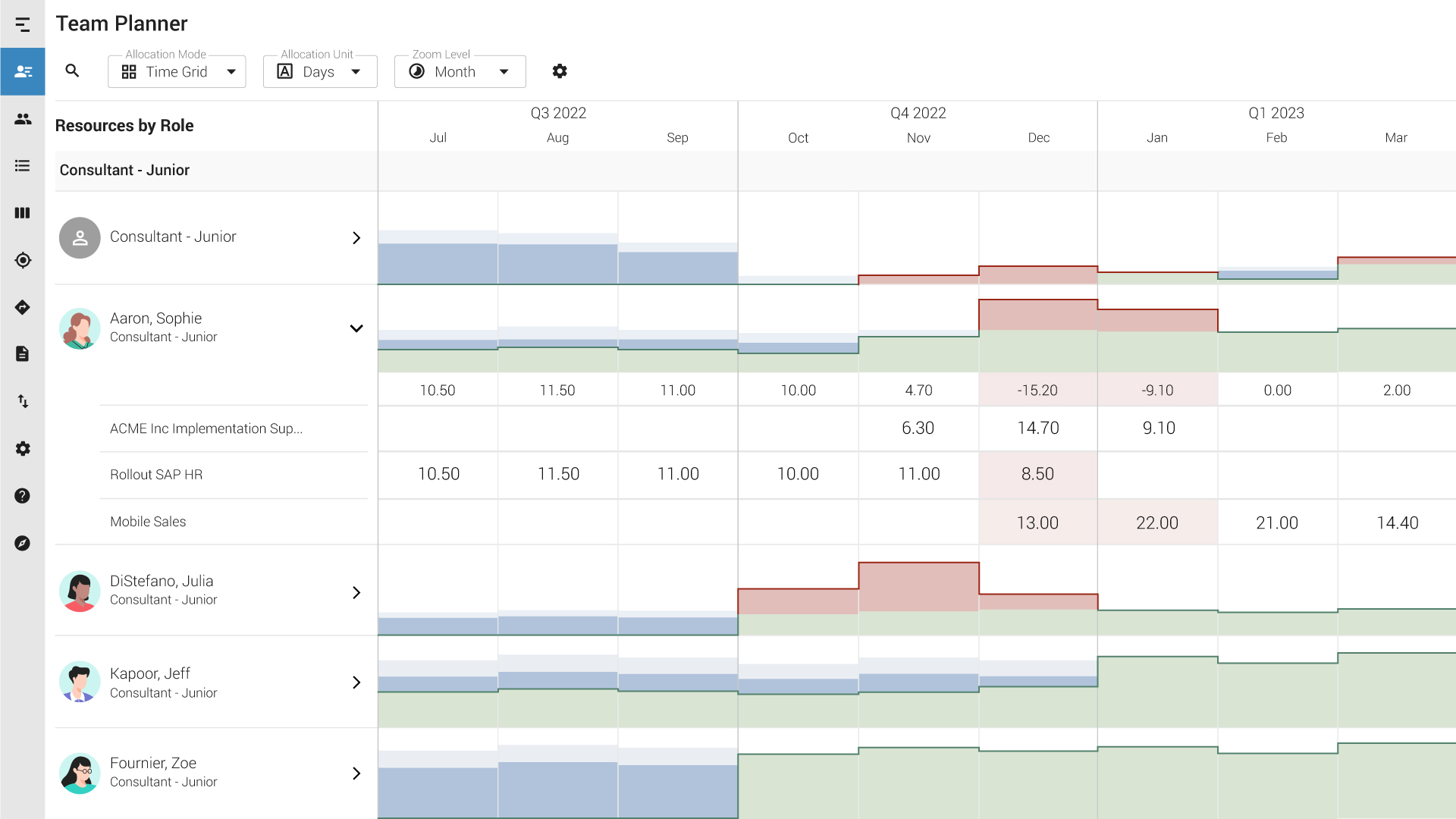What is Resource Utilization?
Resource utilization describes the extent to which available resources (i.e., employees) are occupied by tasks or projects in a given period.
Resource Utilization:
Definition | Examples | Synonyms
Resource utilization is a key concept in project and resource management. It describes the relationship between an employee’s available capacity and the actual workload assigned to them. In practice, this answers the question, “how much of the available working time is actually being used for the planned tasks?”
This helps to identify bottlenecks, underutilization, or overworking at an early stage. It is often expressed as a percentage or in hours. In percentages, a workload of 100% means that all available hours are being used. Values above 100% indicate overutilization and values below 100% indicate underutilization.
In today’s working environment – with several projects running simultaneously, frequently changing priorities, and limited employee capacity – a balanced utilization of resources is crucial for success. The goal is not maximum utilization, but realistic and sustainable utilization so employees can stay productive and satisfied without major stress.

A Practical Example
Lisa is a project manager in a medium-sized IT company. She manages several projects at the same time and regularly schedules developers from different teams. In a typical month, the employees have around 160 hours available per person.
Lisa uses a resource planning tool to see how many hours are available.
Her developer, Max, is scheduled for 180 hours – in other words, he’s overloaded. At the same time, his colleague, Anna, is only scheduled for 90 hours – she is underutilized. Without a clear overview, Lisa would not have recognized this imbalance. She can now redistribute tasks and create a more even workload. This not only increases productivity, but also team satisfaction.

Synonyms und Abbreviation
In practice, the following terms may be used synonymously with resource utilization:
- Capacity utilization
- Employee utilization
- Workload
- Resource allocation
There are no typical abbreviations. You may see simply “utilization” as a short form.
FAQ
Utilization is calculated by dividing the planned effort (in hours) by the available capacity (in hours).
| Formula: Planned working hours / available hours = resource utilization |
Example 1:
Jessica works 40 hours a week. She is assigned a task on a new project, planned for 30 hours.
Calculation:
30h planned effort / 40h available = 0.75
→ Jessica is working at 75% capacity. This means that she still has enough buffer for other tasks or any bottlenecks.
Example 2:
Jacob is a part-time employee and only works 20 hours a week. He is scheduled for 30 hours on the same project.
Calculation:
30h planned effort / 20h available = 1.5
→ Jacob is working at 150% capacity. The calculation shows that resources need to be balanced out so that Jacob’s workload does not exceed his capacity.
An ideal workload is usually between 80% and a maximum of 95%. This leaves enough of a buffer for meetings, illness, or unplanned tasks. If the workload is below 80%, employees may feel bored or underappreciated.
Longterm overload can lead to stress, errors, delays, dissatisfaction, and even illness among employees. In projects, this can lead to missed deadlines, bottlenecks, or budget overruns.
Good resource utilization ensures that projects are implemented efficiently and that teams are not underutilized or overburdened, especially in multi-project environments.
Yes. Tools such as Meisterplan can help you visualize capacity utilization, identify bottlenecks, and run through various scenarios before problems arise.
A transparent workload overview shows which projects are realistically feasible, which enables leadership to make well-founded decisions. Strategic projects with a high priority should be given priority resources.
Resource utilization plays an important role in project portfolio management (PPM). It shows whether there is enough capacity for all planned projects. Projects can only be prioritized sensibly when you have a clear overview of capacity utilization. In this way, you can avoid problems on important projects due to a lack of resources or teams being overloaded. A good utilization overview helps you to make well-founded decisions for the entire portfolio.
Resource Utilization with Meisterplan
In Meisterplan, you can optimize resource utilization through clear visualizations and real-time data. This allows you to identify and avoid bottlenecks at an early stage.
In the Team Planner, you can easily see how busy employees or teams are using the histogram, and you can easily edit allocations.
With the Portfolio Designer, you can view the projects together with their associated resource utilization using a combination of the histogram and Gantt chart. Thanks to various scales, colors, and filters, you can view and compare different aspects.
With scenario planning, you can simulate different workload scenarios to find the best possible resource allocations. Consequently, this allows you to manage projects efficiently and avoid overloads while maintaining a sustainable workload.

Discover More Here!
Dive even deeper into the topics of project, portfolio and resource management: Each page offers expert knowledge, product insights and a wealth of experience we'd like to share with you.

What Is Meant by “Resources”?

What is Optimal Resource Utilization?
